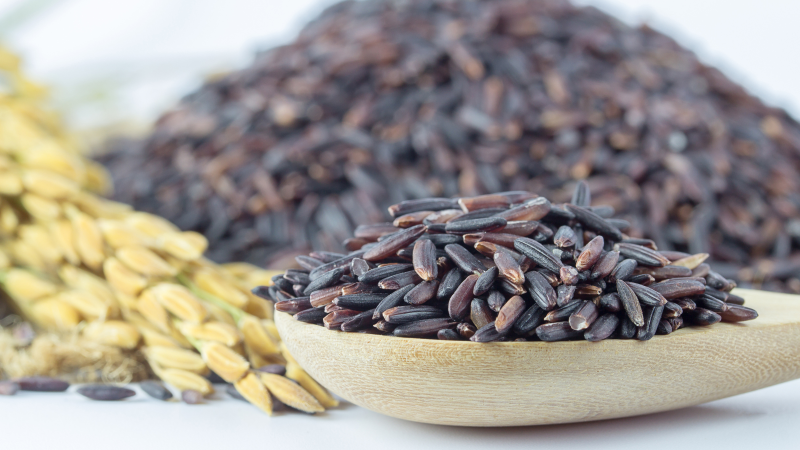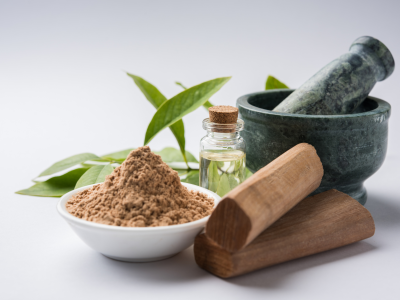
Kavuni rice is a traditional and aromatic rice variety predominantly grown in Tamil Nadu and other parts of southern India. It's known for its distinctive black colour, rich history, and nutritional value. Kavuni rice is often used in festive dishes and has gained attention for its health benefits, making it a cherished grain in traditional South Indian cuisine.
Key Characteristics of Kavuni Rice:
-
Appearance:
- Kavuni rice is a black rice variety, with small to medium-sized grains. When cooked, the rice turns a deep purple-black colour, making it visually striking. The grain retains its dark hue even after cooking, which adds a beautiful contrast to dishes.
-
Aroma:
- Kavuni rice has a mild, earthy fragrance, often described as a natural, sweet smell. This makes it a popular choice for special dishes that require a unique aroma, such as pongal or payasam (a type of rice pudding).
-
Texture:
- The texture of Kavuni rice is typically chewy, similar to other black rice varieties. It has a slightly sticky consistency when cooked, which makes it suitable for both savoury and sweet preparations.
Nutritional Benefits of Kavuni Rice:
-
Rich in Antioxidants:
- Like other black rice varieties, Kavuni rice is loaded with anthocyanins, the powerful antioxidants that give it its dark colour. These antioxidants help protect the body from oxidative stress and free radical damage, potentially lowering the risk of chronic diseases like heart disease and cancer.
-
High in Fiber:
- Kavuni rice is a whole grain, meaning it retains its bran and germ layers. As a result, it’s higher in dietary fiber than polished white rice. This makes it beneficial for digestive health, as it promotes regular bowel movements and can help in maintaining healthy cholesterol levels.
-
Rich in Iron:
- Kavuni rice is known for its iron content, which makes it a good choice for those dealing with iron-deficiency anemia. Consuming this rice regularly can help boost iron levels, especially when paired with vitamin C-rich foods to enhance absorption.
-
Good Source of Protein:
- While not as protein-dense as some legumes, Kavuni rice contains a decent amount of plant-based protein, making it a good addition to vegetarian and vegan diets.
-
Low Glycemic Index:
- Kavuni rice has a relatively low glycemic index compared to white rice, meaning it causes a slower, more gradual rise in blood sugar levels. This makes it a healthier option for people managing diabetes or anyone looking to maintain stable energy levels throughout the day.
-
Gluten-Free:
- Like most rice varieties, Kavuni rice is naturally gluten-free, making it suitable for people with celiac disease or those following a gluten-free diet.
Culinary Uses of Kavuni Rice:
-
Kavuni Rice Payasam:
- One of the most popular dishes made with Kavuni rice is Kavuni rice payasam, a traditional South Indian dessert. This sweet dish is prepared by cooking the rice with coconut milk, jaggery, and cardamom, making for a rich, creamy, and aromatic dessert that's often served during festivals and special occasions.
-
Kavuni Rice Pongal:
- In Tamil Nadu, Kavuni rice is sometimes used to prepare Kavuni rice pongal, a variation of the traditional Pongal dish, where the rice is cooked with lentils, black pepper, and ghee to make a savoury dish.
-
Rice for Pulao or Pilaf:
- Kavuni rice can be used in place of other varieties of rice for preparing pulaos or pilafs. Its slightly nutty flavour pairs well with spices and vegetables, making it a good base for many rice-based dishes.
-
Kavuni Rice with Curd:
- A simple, yet flavorful dish made by serving cooked Kavuni rice with curd (yogurt) and a sprinkling of salt and spices. This is a common accompaniment in South Indian meals.
-
Salads and Rice Bowls:
- Kavuni rice can also be used in salads or rice bowls, adding a rich, earthy flavour and vibrant colour to the dish. It works well with vegetables, nuts, and light vinaigrettes.
Cultural Significance:
- Kavuni rice is an ancient variety that has been cultivated in the Southern Tamil Nadu region for centuries. It is closely linked with traditional agricultural practices and is often associated with the Tamil New Year and other South Indian festivals.
- Historical Importance: In Tamil culture, Kavuni rice is considered an offering to the gods and is often included in religious and auspicious occasions, making it a symbolic food for prosperity and health.
How to Cook Kavuni Rice:
- Soaking: It’s a good idea to soak Kavuni rice for a few hours or overnight before cooking to reduce cooking time and enhance the texture.
- Cooking Ratio: Use 2-3 cups of water for every 1 cup of Kavuni rice. The rice will absorb a significant amount of water due to its unique texture, so you may need to adjust the water ratio depending on your desired consistency.
- Cooking Time: Kavuni rice typically takes about 40–50 minutes to cook, so be patient and check occasionally to ensure it’s soft but not mushy.
- Cooking Methods: You can cook Kavuni rice in a traditional pot, rice cooker, or pressure cooker (adjusting the cooking time accordingly).
Where to Buy Kavuni Rice:
- Kavuni rice is not as commonly found in mainstream supermarkets, but it can often be purchased from specialty health food stores, local Indian grocery stores, or online retailers.
- It may be labeled as black rice, forbidden rice, or Chakhao rice (particularly in northeastern India, where similar black rice varieties are grown).
Conclusion:
Kavuni rice is a nutritious, culturally significant, and flavourful variety of rice that has earned a place in the hearts of many for its health benefits and delicious taste. Whether used in traditional South Indian dishes like payasam and pongal or in modern rice bowls and pilafs, Kavuni rice offers a nutritious alternative to other rice varieties while also carrying historical and cultural value. Its striking colour, unique flavour, and health benefits make it a valuable addition to any kitchen.

















Leave a comment